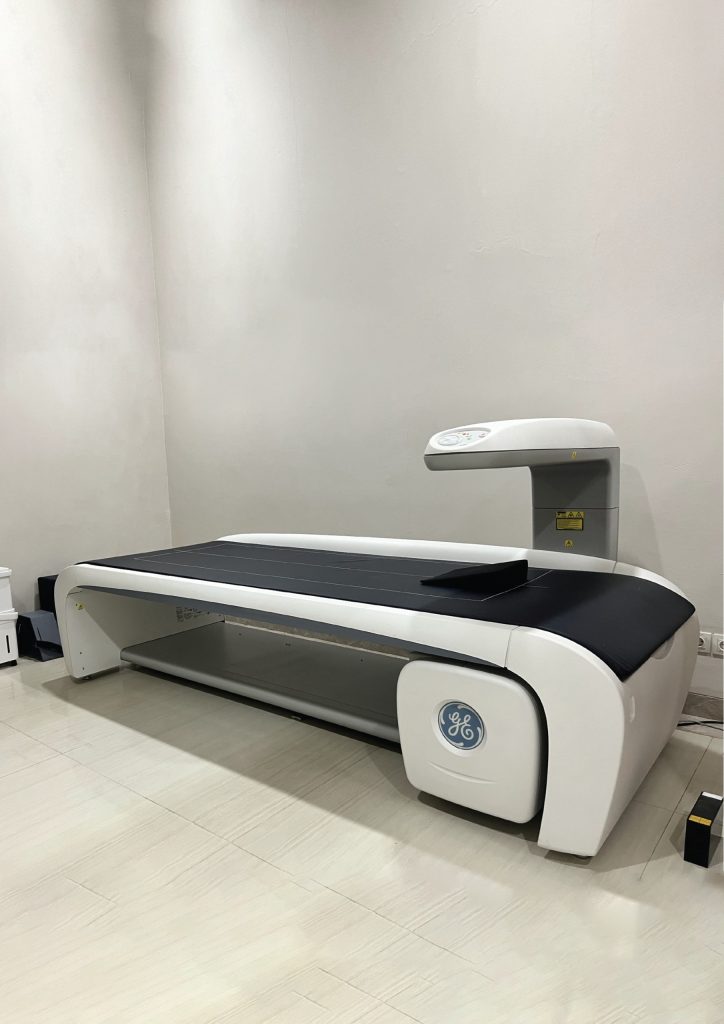Oleh: Thalia Kaylyn Averil
Bone Mineral Density (BMD), which uses Dual-energy X-ray Absorptiometry (DXA), is a screening method for assessing the risk of bone fractures that has been globally recognized. Bone mineral density can be assessed based on the amount of calcium and other minerals in certain areas of the bone. This procedure can detect osteoporosis or bone loss and determine the patient’s risk of bone fracture.

Figure 1. BMD-DXA at Abdi Waluyo Hospital.
Bones consist of inorganic materials such as calcium and phosphate, as well as organic components such as collagen and protein. Bone is a dynamic tissue that is constantly renewed by cells called osteoclasts and osteoblasts. The balance between these cells determines bone health. Osteoporosis occurs when there is more bone loss due to damage than new bone formation. This imbalance can occur despite normal or even high rates of bone formation. On the other hand, osteopenia is a condition of bone loss that is milder than osteoporosis. BMD-DXA is a safe method of measuring bone mass and can predict the risk of fracture. Low BMD is associated with an increased risk of fracture, whereas high BMD is associated with a reduced risk of fracture. The body parts most commonly subjected to BMD-DXA procedures are the lower spine, wrist, and hip because the bones in these areas are the most vulnerable to fractures due to osteoporosis.
BMD-DXA may be performed to check for the following conditions to diagnose and treat osteoporosis and osteopenia as soon as possible. Bone fractures due to osteoporosis have serious consequences, especially for the elderly.If diagnosed early enough, osteoporosis can be prevented from worsening rapidly with treatment, thereby avoiding the risk of bone fractures. Bone density tests can be used to:
- Confirm a diagnosis of osteoporosis, especially if you have previously had a bone fracture.
- Predicts your likelihood of having a bone fracture in the future.
- Determine your rate of bone loss.
- Check the effectiveness of your treatment.
BMD-DXA or bone density test has several indications, mainly based on osteoporosis risk factors. Typical risk factors for osteoporosis include:
- Men over 70 years old and women over 65 years old
- Postmenopausal women
- Smoking
- Consuming alcohol excessively
- Low body mass index (BMI)
- Have a family history of hip fractures
- Using steroids long term
- Having diseases such as hyperthyroidism, hyperparathyroidism, rheumatoid arthritis, type 1 diabetes mellitus, liver disease, or kidney disease
In the BMD-DXA test results, your bone mineral density will be compared with healthy young adults aged around 25 to 35 years so that it will show a result called a T-score. In addition, bone mineral density will also be compared with adults of the same age which will show a Z-score. The difference between your bone mineral density and other bone mineral densities is called the standard deviation (SD). If the T-score of a bone is positive, it means the bone is stronger than normal and the bone is weaker than normal if the T-score is negative. For the Z-score, the same formula is used to calculate the Z-score, but the comparison is made with people who are similar to you in terms of height, weight, race, gender, and age.
According to the World Health Organization (WHO), osteoporosis is related to the level of bone density:
- Normal bone density is indicated by a T-score that is within 1 SD (+1 or -1) of the average for young adults.
- Low bone density is characterized by a T-score at 1 to 2.5 SD below the average for young adults (-1 to -2.5 SD).
- Osteoporosis is present if the T-score is 2.5 SD or more below the average for young adults (more than -2.5 SD).
For each standard deviation below normal, the risk of bone fracture generally doubles. After obtaining the BMD-DXA results, individuals at high risk of fractures can be treated to prevent fractures in the future. If someone has had one or more fractures due to osteoporosis and their bone density is 2.5 standard deviations lower than the average young adult, then they likely have severe osteoporosis.

Figure 2. Interpretation of T-score on BMD-DXA.
What needs to be prepared for BMD-DXA?
- The patient needs to lie on his back for approximately ten minutes.
- Patients are not advised to take calcium supplements the day before the test.
- Patients who are experiencing menopause are advised to do a pregnancy test beforehand.
- Patients should wear loose and comfortable clothing and avoid clothing with metal accessories, such as zippers.
Resources
- Haseltine KN, Chukir T, Smith PJ, Jacob JT, Bilezikian JP, Farooki A. Bone Mineral Density: Clinical Relevance and Quantitative Assessment. J Nucl Med [Internet]. 2021 Apr [cited 2024 Feb 24];62(4):446-54. Available from: https://www.ncbi.nlm.nih.gov/pmc/articles/PMC8049374/
- Krugh M, Langaker MD. Dual-Energy X-Ray Absorptiometry. [Updated 2023 Jun 5]. In: StatPearls [Internet]. Treasure Island (FL): StatPearls Publishing; 2024 Jan-. Available from: https://www.ncbi.nlm.nih.gov/books/NBK519042/
- Johns Hopkins Medicine. Bone Densitometry [Internet]. Baltimore: Johns Hopkins Medicine; date of publication unknown [cited 2024 Feb 24]. Available from: https://www.hopkinsmedicine.org/health/treatment-tests-and-therapies/bone-densitometry
